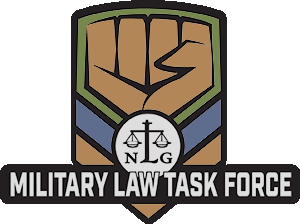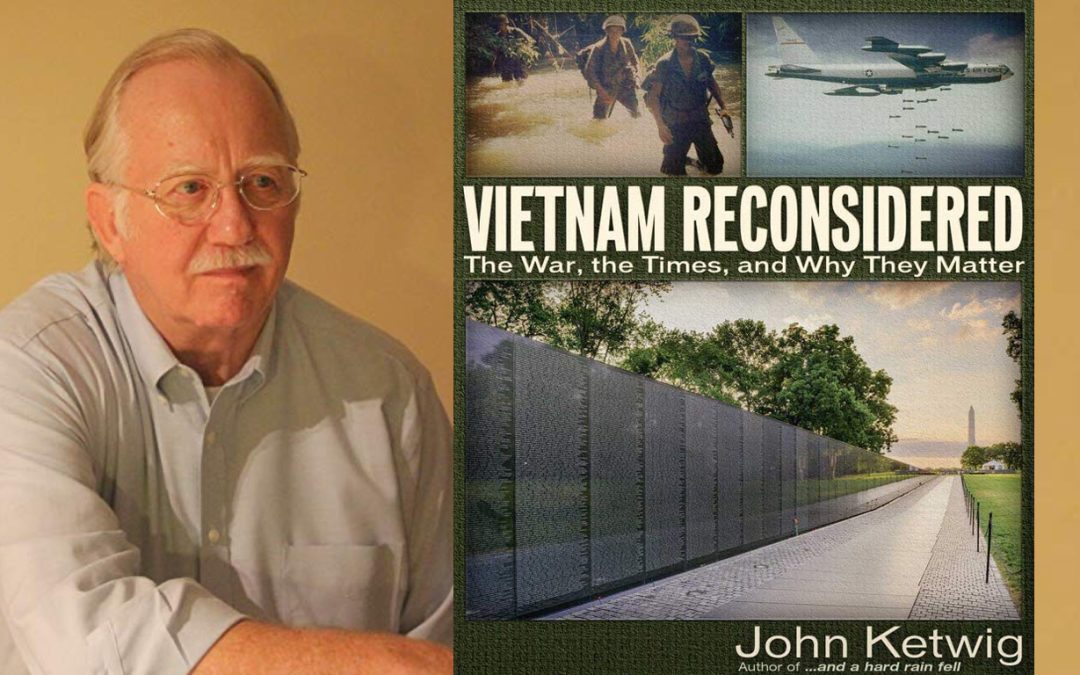By Chris Ford
The debacle in Vietnam informs today’s costly militarism

By John Ketwig
Trine Day
2019 330 pp.
Editor’s Note: This review examines John Ketwig’s latest book. His previous book was the much acclaimed …and a hard rain fell: A GI’s True Story of the War in Vietnam.
“Vietnam! The word carries a dark, heavy stigma,” intones author John Ketwig, whose information-packed volume, Vietnam Reconsidered: The War, the Times and Why They Matter, was released this year. The book, says Ketwig, “is guided by the belief that war is the most abhorrent and despicable behavior of all human endeavors, and it should not be glorified.”
An admitted “angry, bitter” Vietnam veteran, Ketwig defines war “as the complete breakdown of all things civilized, and the utter failure of human beings to respect each other,” and “the surrender to the hopeless.” The war in Vietnam “and the truths it exposed,” he writes, “are enormously important to the America our kids will inherit.”
Wide-ranging volume
America unequivocally lost the Vietnam war (and Southeast Asia lost 3.5 – 5 million of its people, mostly civilians, to horrific deaths), prompting top military, government, business and media officials – or “the Establishment,” in the parlance of the Vietnam era – to cry “never again.” But these economically and politically dominant members of society did not seek an end to brutal, unjust and pointless warfare; they demanded “never again” to honest, realistic news coverage that presents war as the utter horror it is. Thus, in the wake of Vietnam, the government, hand-in-hand with rogue “intelligence” agencies, war profiteers, arms merchants and mercenary firms, has relentlessly marketed the nation’s war efforts, no matter how fruitless or costly; has hidden or lost many trillions in costs; and has strenuously attacked and sought to discredit opponents of war.
Ketwig’s book focuses on the horrors of war and its aftermath – including the tragic fact that as a result of his exposure as a Vietnam soldier to a toxic “defoliant” known as Agent Orange, which the U.S. military liberally sprayed all over South Vietnam during the war, Ketwig lost his only son when the child was just 14 days of age. The book also focuses on the press coverage and protest during the war; government propaganda; and the corruption on an almost unimaginable scale during the war and, especially, in today’s Pentagon which has allowed literally trillions of dollars to slip through its fingers and into unknown hands.
However, the book also touches on such 20th century and Cold War issues as the Berlin Airlift, the space race, the draft, the Veterans Administration, the assassinations of John F. Kennedy, Martin Luther King and Robert Kennedy, the predominate culture of the 1960s, the Vietnam war’s carnage and injustices, and military corruption and fraud. It also examines the destructive and sometimes long-delayed effects of PTSD and the mental picture of Vietnam veterans. At a time when PTSD was not part of the national lexicon, family members observed that their Vietnam veteran loved ones had “changed” as a result of the war.
Importantly, the book also discusses what Ketwig calls “the Myth,” which he describes as “a vast disinformation campaign to make the American public feel guilty for ‘mistreating’ Vietnam veterans when they came home.” The reality, he suggests, is that the raw deal Vietnam soldiers and veterans received was from their own government, which had lied to and maltreated them and had forced them to take part in a barbaric and pointless war. Vietnam vets “were ignored, ostracized, or scapegoated, perhaps more within the military than in civilian life,” he writes.
Yanked from a ‘colorful world’
For those who did not experience the era, the 1960s offered the average American a far rosier economic picture than is available today. The U.S. enjoyed the longest uninterrupted period of economic expansion in its history, benefiting from massive government investment during the 1950s in the Interstate Highway system, the GI bill, the Apollo space program, primary and secondary education and, of course, DARPA, which gave rise to such 21st century standbys as GPS, the Internet and voice-to-text technology. California’s visionary governor from 1959-1967, Edmund G. “Pat” Brown, left the state that now is home to one in eight Americans with 1,000 miles of new freeways; a massive system of dams, canals and pipelines that brought water from the state’s rainy north to its sunny, economically booming south; and a greatly expanded, world-class university system.
Public college during the 1960s was all but tuition-free, healthcare was a minor household budget item, and housing was more affordable, especially along the coasts. In short, a middle-class life was available even to those with only a high school diploma, and it was an era of what Ketwig calls “stubborn optimism.” Seventy percent of the nation’s growth occurred in the car-centric suburbs, and the easy availability to baby boom teenagers of cars – which they “strained their wallets” to make “fast and loud” – gave them “access to all manner of exciting events that no previous generation had ever known.”
Before he received “the letter” from the draft board, Ketwig, holder of no more than a high school diploma, drove a Thunderbird, with its “most luxurious and sporty interior,” had a good job learning a trade, played drums in a band and enjoyed an “extremely fast-paced and fun” life. “We had come of age surrounded by vivid colors and an all-American atmosphere of freedoms expressed as irreverent, defiant adolescent rebellion,” he writes.
However, as soon as he opened the letter, his world collapsed. His band didn’t need him, he couldn’t find a date on Saturday night, and he could not attain a deferral from the war, because his employer did not want to do the paperwork to make him an apprentice, and he could not afford college. “We were taken against our will, yanked away from our affluent and colorful worlds, our long hair was unceremoniously sheared, and our colorful mod Carnaby Street-inspired clothes were stripped from us,” he writes. “To be snatched away from all that, to be assigned a baggy uniform of olive drab and to find ourselves seeking cover in the Vietnamese mud while bullets shrieked overhead” was traumatic.
The carnage in Vietnam
The Vietnam Veterans Memorial in Washington, D.C. displays 58,315 names of Americans missing or killed in the Vietnam war. About 153,000 Americans were injured, among whom about 23,000 returned home “100% disabled.” At least 10,000 lost one or more limbs – more than in WWII and the Korean war combined, according to Ketwig’s book.
Beyond the 3.5 to 5 million lives lost among the Vietnamese, Laotians and Cambodians as a result of the U.S.’s military efforts between 1964 and 1975, between 1 and 2.5 million South Vietnamese were sent to “re-education camps,” at which an estimated 165,000 died; between 50,000 and 250,000 were executed; and the UN estimated 200,000 and 400,000 refugees seeking to escape by boat (and called “boat people”) died at sea, “with other estimates much higher,” according to Ketwig. Unexploded ordinance has killed another 42,000 since the war.
But it is suicide of Vietnam war veterans, which Ketwig calls “the ultimate expression of PTSD,” that is the ongoing, tragic legacy of the Vietnam war, with one veteran taking his life every hour, and 10 survivors of suicide attempts for each one who ends his life. There also are “trip-wire vets,” men who are reclusive, living in remote, hand-built cabins and out of touch with everyone, including their families.
As has been reported in On Watch, suicide in the military remains a serious problem. Ketwig relates the story of an acquaintance whose son deployed to Iraq with eight other men from a small, rural community. A year and a half after their return, four of the nine had committed suicide.
The cruelty of the military
Ketwig suggests that while the military effort in Vietnam failed, the war served the Pentagon’s underlying purpose, which was to test weapons systems and military methods. The U.S. military dropped more bombs on southeast Asia during the Vietnam war than in all of WWII. Between 1965 and 1967 alone, the U.S. dropped 1.5 million bombs on New Mexico-size Vietnam, “including a substantial portion on South Vietnam, our supposed ally and an impoverished, agricultural society,” Ketwig writes.
Among the items the Pentagon “tested” on the Vietnamese were cluster bombs that threw up to 600 “bomblets” up to 30 feet in every direction, each filled with “ragged metal ball bearings or other shrapnel scientifically designed to impose the maximum damage to the human body,” including “razor sharp plastic slivers [that] would not show up in an X-ray.”[1]
The U.S. also “tested” white phosphorous in Vietnam. This substance ignites at 86 degrees but burns at about 10,000 degrees and is difficult to extinguish. “The sight of a human body burned by white phosphorous is not easily consigned to memory,” Ketwig explains. Direct skin contact leads to thermal and chemical burns, and particles of the substance can enter the body through burns or other wounds “and continue to damage tissues” and produce corrosive phosphoric acids.[2] As the Washington Post reported, when white phosphorous “comes in contact with flesh, it can maim and kill by burning to the bone.”[3]
White phosphorous was banned as a chemical weapon in the 1980 Convention on Conventional Weapons. The U.S. was not among the 80 nations to sign this agreement, and it used white phosphorous against Iraqis in retaliation for the killing of four Blackwater mercenaries in Fallujah, Iraq, in 2005.[4] The U.S. also reportedly used white phosphorous in Syria as recently as 2017.[5]
The military additionally poisoned Vietnamese croplands with Agent Orange – which contains Dioxin, said to be the most toxic substance on Earth, and the effects of which are showing up in the grandchildren of those exposed in Vietnam – and “consumed [them] in flaming infernos of napalm.” Ketwig writes. The National Academy of Sciences reported in 1974 that the use of herbicides such as Agent Orange in Vietnam had done damage to the nation’s ecology that could last up to 100 years, he reports.
The M-16 assault rifles that the U.S. military “tested” in Vietnam used a type of bullet designed “to tumble so that, on contact with any part of a human body, it would cause maximum damage,” according to Ketwig. Assault rifles “in wide use by civilians in America today utilize the same technology,” he notes.
And the military was not exactly kind to its Vietnam soldiers. Basic training “was traumatic,” and “[f]rom the very start, the things I saw and experienced in basic training then in Vietnam devastated my heart and soul,” Ketwig writes. Ripped from his comfortable, affluent life, the GI suddenly “found himself on the other side of the planet scared to death and struggling just to survive. His life had become a terrifying, surreal nightmare, and he was hopelessly trapped by an enormous, all-powerful, uncaring and often immoral system.”
The press and propaganda
The Vietnam War was the first to be brought into American living rooms on color television. Weekly news magazines also brought home vivid war imagery. For example, LIFE magazine ran an article in June 1969 entitled, “The Faces of the American Dead in Vietnam: One Week’s Toll,” complete with the face of a deceased “boy next door” on the cover.[6]
“Inside, across 10 funereal pages, LIFE published picture after picture and name after name of 242 young men killed in seven days halfway around the world ‘in connection with the conflict in Vietnam.’”[7] Time further reports, “To no one’s surprise, the public’s response was immediate, and visceral,” and while some condemned the effort as supporting the anti-war protesters, “others – perhaps the vast majority – were quietly and disconsolately devastated.”[8] Ketwig reports that 63 journalists were killed reporting from Vietnam. These, perhaps, should be seen as the true heroes of the Vietnam war.
Protesters and their persecution
Protest during the Vietnam era is legendary. One 1967 anti-war protest that drew 50,000 to 100,000 people generated a famous photograph of a woman placing a flower into the barrel of a soldier’s rifle, which became a symbol of the use of the military to silence the Establishment’s critics. In just one weekend in May 1970, 4 million Americans took to the streets to protest the war (at a time when the population of the U.S.A. was just 205 million).
Additionally, Ketwig notes that for the first time, active duty soldiers joined veterans to protest the war in which they served at a march in San Francisco during October 1968. Further, the generation that grew up free and defiant could not be completely contained even in the military. By 1972, 25% of all Americans in uniform either deserted, were AWOL, refused orders or were openly mutinous, according to Ketwig.
The Establishment busied itself painting the opposition as “Communists” – just as the G.W. Bush administration and other government officials in the first years of the current century painted opponents to its pro-war policies as “terrorists.”[9] President Johnson “committed a massive force of government, military, and intelligence forces against the unruly crowd of American Citizens attempting to exercise their constitutional right of Freedom of Speech,” Ketwig states.
The Nixon Administration stepped up the game by creating “contingency
plans to deal with future demonstrations” in Washington D.C., with the ability
to mobilize a military force “equal to one-fifth of the size of the U.S. Army
presence in Vietnam”; escalated the use of surveillance, infiltrators, phone
taps, meeting disruptions, and people trained to instigate illegal activities
by anti-war groups; and “compiled computer flies on 18,000 ‘enemies,’ including
members of Congress and civic leaders,” according to Ketwig.
Pentagon Waste, Corruption and Fraud
News reports cited by Ketwig show that trillions of dollars in Pentagon spending has gone unaccounted for, so as to make the days of $37 screws, $435 claw hammers, $640 toilet seats, $2,228 monkey wrenches, $7,600 coffee pots and $74,165 aluminum ladders of the 1980s Pentagon spending overruns[10] appear paltry by comparison.
In one shocking example, up to more than $18 billion in American $100 bills – enough to fill 21 C-130 cargo planes! – were unloaded in Baghdad, Iraq, in May 2004 and “just disappeared,” according to Ketwig. “ The US has audited the money three times, but has still not been able to say exactly where it went.”[11] Taking a position that simply cannot pass the laugh test, “Pentagon officials have contended for the last six years that they could account for the money if given enough time to track down the records.”[12]
On September 10, 2001 former defense secretary Donald Rumsfeld announced at a press conference that “we cannot track $2.3 trillion” in Pentagon transactions, at a time when the Pentagon’s budget was about $313 billion.[13] The next day, the 9/11 attacks wiped this massive revelation of fraud off the front page, and there has been no follow-up or effort to find the missing money.[14]
The Nation news magazine describes a process called “nippering,” in which the Pentagon shifts money from its congressionally authorized purpose to a different purpose, and when done multiple times the funds can become virtually untraceable.[15] As cited by Ketwig, the U.S. Army in 2015, when its allocation from Congress was $122 billion, spent $6.5 trillion (yes, trillion with a “t”) in unaccounted funds.[16] The Treasury Department gave the Army a “cash deposit” of nearly $800 billion that same year – an amount larger than the Pentagon’s entire military appropriation for the year, Ketwig reports. He adds that 16,500 documents and records “disappeared from the Defense Department Reporting System” in the third quarter or 2015, “with no explanation of why they were removed or where they went.”
Overall, the Pentagon engaged in $21 trillion in transactions “between 1998 and 2015 [that] could not be traced, documented, or explained,” according to Michigan State University professor Mark Skidmore, who reviewed DoD financial records with two graduate students.[17]
The national debt – which was less than $1 trillion when Reagan, a supposed fiscal conservative, took office but had nearly tripled to $2.857 trillion when he left – reached $22 trillion in February 2019, with a “defense” budget of nearly $1 trillion for the year. “Is this an ironic coincidence or what?” Ketwig queries rhetorically. “The national debt is at $21.8 trillion [as of January 2019], and the Pentagon can’t tell us where $21 trillion of its funds have gone.” Ketwig further notes that just the interest on the national debt, $67 billion, equals Russia’s military expenditures for the year. It is almost farcical that in light of the reported waste, fraud and apparent “loss” of so much money by the Pentagon, West Point announced a few years ago that it was discontinuing its ethics classes, according to Ketwig.
Conclusion
In his Introduction, Ketwig says his book “contains many suggestions, a mosaic of historical fragments arranged to create an overall picture, colorful and heavy as chips of stone.” This description is accurate, given the wide range of topics and organization of the material. And while the volume is filled with statistical and historic information; anecdotes from Ketwig’s own experiences and those of other vets and their family members; and historical background, it also includes the author’s own strongly held opinions that the nation’s spiraling militarism is dangerous, wasteful, cruel, costly, harmful and unjustified, and it grossly distorts economic and political choices.
“I love to imagine an America with universal healthcare, pothole-free super highways, the best educational system in the world, a thriving economy that rewards everyone proportionate to what they produce, but takes care of our disadvantaged and affords them the very finest quality of life,” Ketwig writes, but the war economy precludes such choices. He also warns that the CIA and NSA’s covert army of more than 70,000 “guerilla warriors” has become “a rogue 4th branch of government, unelected, and defiantly resistant to any oversight, much less checks and balances.”
A recurring theme in Ketwig’s book is the frustrating reality that the architects of Vietnam managed to escape any responsibility for their actions, and he wonders whether the public can overcome the CIA, NSA and the federal government’s 15 other “intelligence” agencies; defense companies; mercenary firms; “and all the other rogue entities profiting from the destruction and death that we export in unthinkable quantities” – i.e., what he calls, accurately, “the military-industrial-political juggernaut.”
“The voice of the people was choked with tear gas in the shadows of the monuments to our founding fathers [during the Vietnam era], and the flag-draped coffins came home by the thousands for no good reason,” Ketwig writes. The American people, he opines, “learned nothing” from Vietnam, because “the profiteers, bureaucrats, and crooks learned how to perfect their scams and increase their dirty profits while generation after generation of soldiers and civilians bleed and die.” Thus, as in the Vietnam era, “we don’t know why our young people are at war, and we don’t know where trillions of dollars are disappearing to.” He urges the reader to “investigate, read and comprehend, and discuss these issues, and consider what kind of country you want the United States of America to be in forty years when our grandchildren inherit what we build for them today.”
Chris Ford, a former newspaper reporter and editor, is an
attorney licensed in California and Arizona whose practice focuses on civil
appellate and trial-level litigation.
[1] Ketwig notes that in 1784 British Royal Artillery Lieutenant Henry Shrapnel came up with the idea of loading ordnance with small, jagged pieces of metal to create an anti-personnel device. P292
[2] White Phosphorous Fact Sheet, Federation of American Scientists, https://fas.org/programs/bio/factsheets/whitephosphorusfactsheet.html
[3] Thomas Gibbons-Neff, U.S.-led forces appear to be using white phosphorous in populated areas in Iraq and Syria, Washington Post, Jan. 9, 2017, https://www.washingtonpost.com/news/checkpoint/wp/2017/06/09/u-s-led-forces-appear-to-be-using-white-phosphorous-in-populated-areas-in-iraq-and-syria/
[4] The National Lawyer Guild’s Military Law Task Force, in a Freedom of Information Act lawsuit against the U.S. Department of Defense, noted that “U.S. Military personnel taking part in the siege [on Fallujah] were criticized for targeting and killing civilians; blocking access to hospitals; intentionally firing on ambulances; and using chemical weapons against the civilian population, including white phosphorus.” Dkt. no. 20, Hiken v. Dept. of Defense, 06-cv-2812, at 11 (filed April 25, 2006) (citing US Used White Phosphorus in Iraq, BBC News, November 16, 2005, http://news.bbc.co.uk/2/hi/middle_east/4440664.stm).
[5] Gibbons-Neff, supra, note 5.
[6] Ben Cosgrove, Faces of the American Dead in Vietnam: One Week’s Toll, Time, May 15, 2014, https://time.com/3485726/faces-of-the-american-dead-in-vietnam-one-weeks-toll-june-1969/
[7] Id.
[8] Id.
[9] A California Department of Justice spokesperson in 2003 told the San Francisco Chronicle, “You can almost argue that a protest against [the so-called war against terrorism] is a terrorist act.” Chris Ford, Reclaiming the Public Forum: Courts Must Stand Firm Against Government Efforts to Displace Dissidence, 2 Tenn. J. Law & Pol’y 146, 175 n.114 (2006).
[10] Jack Smith, $37 screws, a $7,622 coffee maker, $640 toilet seats: suppliers to our military just won’t be oversold, Los Angeles Times, July 30, 1986, https://www.latimes.com/archives/la-xpm-1986-07-30-vw-18804-story.html.
[11] Missing Iraq cash ‘as high as $18bn,’ Al Jazeera, June 19, 2011, https://www.aljazeera.com/news/middleeast/2011/06/201161962910765678.html.
[12] Id.
[13] Dave Lindorff, Exclusive: The Pentagon’s Massive Accounting Fraud exposed, The Nation, Nov. 27, 2018, https://www.thenation.com/article/pentagon-audit-budget-fraud/.
[14] Id.
[15] Id.
[16] Id.
[17] Lindorff, supra, note 24.



